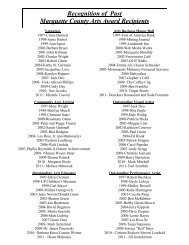Parks & Recreation Five Year Recreation Plan ... - City of Marquette
Parks & Recreation Five Year Recreation Plan ... - City of Marquette
Parks & Recreation Five Year Recreation Plan ... - City of Marquette
You also want an ePaper? Increase the reach of your titles
YUMPU automatically turns print PDFs into web optimized ePapers that Google loves.
Racial and Ethnic Trends<br />
<strong>Parks</strong> and <strong>Recreation</strong> Master <strong>Plan</strong> Update 2011<br />
<strong>City</strong> <strong>of</strong> <strong>Marquette</strong><br />
The <strong>City</strong> <strong>of</strong> <strong>Marquette</strong> is predominantly white (about 91%). Black or African Americans form the<br />
largest minority group with over 500 people (4.4%), followed by American Indian (1.5%) in the<br />
<strong>City</strong> <strong>of</strong> <strong>Marquette</strong>.<br />
Race<br />
Table 2-2: Racial and Ethnic Groups<br />
<strong>City</strong> <strong>of</strong> <strong>Marquette</strong><br />
9<br />
<strong>Marquette</strong><br />
County<br />
Number Percent Number Percent<br />
White 19,455 91.1 62,911 93.8<br />
Black or African American 946 4.4 1,141 1.7<br />
American Indian and Alaska Native 316 1.5 1,161 1.7<br />
Asian 188 0.9 358 0.6<br />
Hispanic or Latino (<strong>of</strong> any race) 309 1.4 767 1.1<br />
Source: U.S. Census<br />
Note: Since 383 people in the <strong>City</strong> and 1,345 in the County reported two or more races, the totals do not add up to 21,355 and the<br />
percentages do not add up to 100%<br />
Household Type and Size<br />
The average household size in the <strong>City</strong> <strong>of</strong> <strong>Marquette</strong> is 2.05, compared to 2.26 for the County.<br />
However, this could be in part due to the amount <strong>of</strong> single person households, younger families<br />
and older households present in the <strong>City</strong> as discussed in later sections. The <strong>City</strong> has a higher<br />
percentage <strong>of</strong> non-family households, single householder households and households where<br />
the householder is over 65, a typical trend in most US cities.



